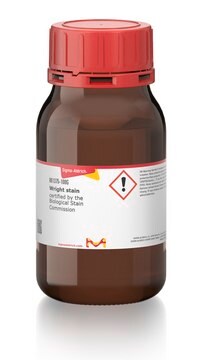W0625
Wright stain
≤4% purity (HPLC), powder
Synonym(s):
Eosin Methylene blue according to Wright
About This Item
Recommended Products
product name
Wright stain, suitable for blood stain
Assay
≤4% (HPLC)
Quality Level
form
powder
concentration
≤4% (HPLC)
color
dark green
solubility
methanol: 10 mg/10 mL
suitability
suitable for blood stain
application(s)
diagnostic assay manufacturing
hematology
histology
storage temp.
room temp
InChI
1S/C20H8Br4O5.C16H18N3S/c21-11-5-9-13(7-3-1-2-4-8(7)20(27)28)10-6-12(22)17(26)15(24)19(10)29-18(9)14(23)16(11)25;1-18(2)11-5-7-13-15(9-11)20-16-10-12(19(3)4)6-8-14(16)17-13/h1-6H,(H2-,25,26,27,28);5-10H,1-4H3/q;+1/p+1
InChI key
AXIKDPDWFVPGOD-UHFFFAOYSA-O
Looking for similar products? Visit Product Comparison Guide
General description
Application
- It is also used for G-banding and helps in the analysis of poorly spread metaphases.
- It has been used to study the cytogenetics of human hematopoietic cells.
- It has also been employed in the karyotyping of human embryonic stem cells.
- It is also used in the staining of chromosomes.
- It is used for the exudate analysis of white blood cell concentration.
Features and Benefits
Preparation Note
Signal Word
Warning
Hazard Statements
Precautionary Statements
Hazard Classifications
Acute Tox. 4 Oral - Eye Irrit. 2
Storage Class Code
11 - Combustible Solids
WGK
WGK 3
Flash Point(F)
Not applicable
Flash Point(C)
Not applicable
Personal Protective Equipment
Choose from one of the most recent versions:
Already Own This Product?
Find documentation for the products that you have recently purchased in the Document Library.
Our team of scientists has experience in all areas of research including Life Science, Material Science, Chemical Synthesis, Chromatography, Analytical and many others.
Contact Technical Service





